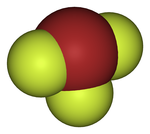Bromine trifluoride

| |

| |
| Properties | |
|---|---|
| BrF3 | |
| Molar mass | 136.90 g/mol |
| Appearance | straw-coloured liquid hygroscopic |
| Odor | Choking, pungent[1] |
| Density | 2.803 g/cm3 [2] |
| Melting point | 8.77 °C |
| Boiling point | 125.72 °C |
| decomposes violently[3] | |
| Solubility in sulfuric acid | very soluble |
| Structure | |
| T-shaped (C2v) | |
| 1.19 D | |
| Hazards | |
| Occupational safety and health (OHS/OSH): | |
Main hazards
|
dangerously sensitive to water, source of HF |
| NFPA 704 (fire diamond) | |
| Related compounds | |
Other anions
|
Bromine monochloride |
Other cations
|
Chlorine trifluoride Iodine trifluoride |
| Supplementary data page | |
| Bromine trifluoride (data page) | |
Except where otherwise noted, data are given for materials in their standard state (at 25 °C [77 °F], 100 kPa).
| |
Bromine trifluoride is an interhalogen compound with the formula BrF3. It is a straw-coloured liquid with a pungent odor.[4] It is soluble in sulfuric acid but explodes on contact with water and organic compounds. It is a powerful fluorinating agent and an ionizing inorganic solvent. It is used to produce uranium hexafluoride (UF6) in the processing and reprocessing of nuclear fuel.[5]
Synthesis
Bromine trifluoride was first described by Paul Lebeau in 1906, who obtained the material by the reaction of bromine with fluorine at 20 °C:[6]
- Br2 + 3 F2 → 2 BrF3
The disproportionation of bromine monofluoride also gives bromine trifluoride:[4]
- 3 BrF → BrF3 + Br2
Structure
Like ClF3 and IF3, the BrF3 molecule is T-shaped. In the VSEPR formalism, the bromine center is assigned two electron pairs. The distance from the bromine each axial fluorine is 1.81 Å and to the equatorial fluorine is 1.72 Å. The angle between an axial fluorine and the equatorial fluorine is slightly smaller than 90° — the 86.2° angle observed is due to the repulsion generated by the electron pairs being greater than that of the Br-F bonds.[7][8]
Chemical properties
BrF3 is a fluorinating agent, but less reactive than ClF3. The liquid is conducting, owing to autoionisation:[5]
- 2 BrF3
⇌ BrF2+ + BrF4- Many ionic fluorides dissolve readily in BrF3 forming fluoroanions:[5]
- KF + BrF3 → KBrF4
References
- ^ a b http://www.chammascutters.com/en/downloads/Bromine-Trifluoride-MSDS.pdf
- ^ Lide, David R., ed. (2006). CRC Handbook of Chemistry and Physics (87th ed.). Boca Raton, FL: CRC Press. ISBN 0-8493-0487-3.
- ^ http://www.mathesongas.com/pdfs/msds/MAT03380.pdf
- ^ a b Simons JH (1950). "Bromine (III) Fluoride - Bromine Trifluoride". Inorganic Synthesis. Inorganic Syntheses. 3: 184–186. doi:10.1002/9780470132340.ch48. ISBN 978-0-470-13234-0.
- ^ a b c Greenwood, Norman N.; Earnshaw, Alan (1997). Chemistry of the Elements (2nd ed.). Butterworth-Heinemann. ISBN 978-0-08-037941-8.
- ^ Lebeau P. (1906). "The effect of fluorine on chloride and on bromine". Annales de Chimie et de Physique. 9: 241–263.
- ^ Gutmann V (1950). "Die Chemie in Bromtrifuoride". Angewante Chemie. 62 (13–14): 312–315. doi:10.1002/ange.19500621305.
- ^ Meinert H (1967). "Interhalogenverbindungen". Zeitschrift für Chemie. 7: 41.

